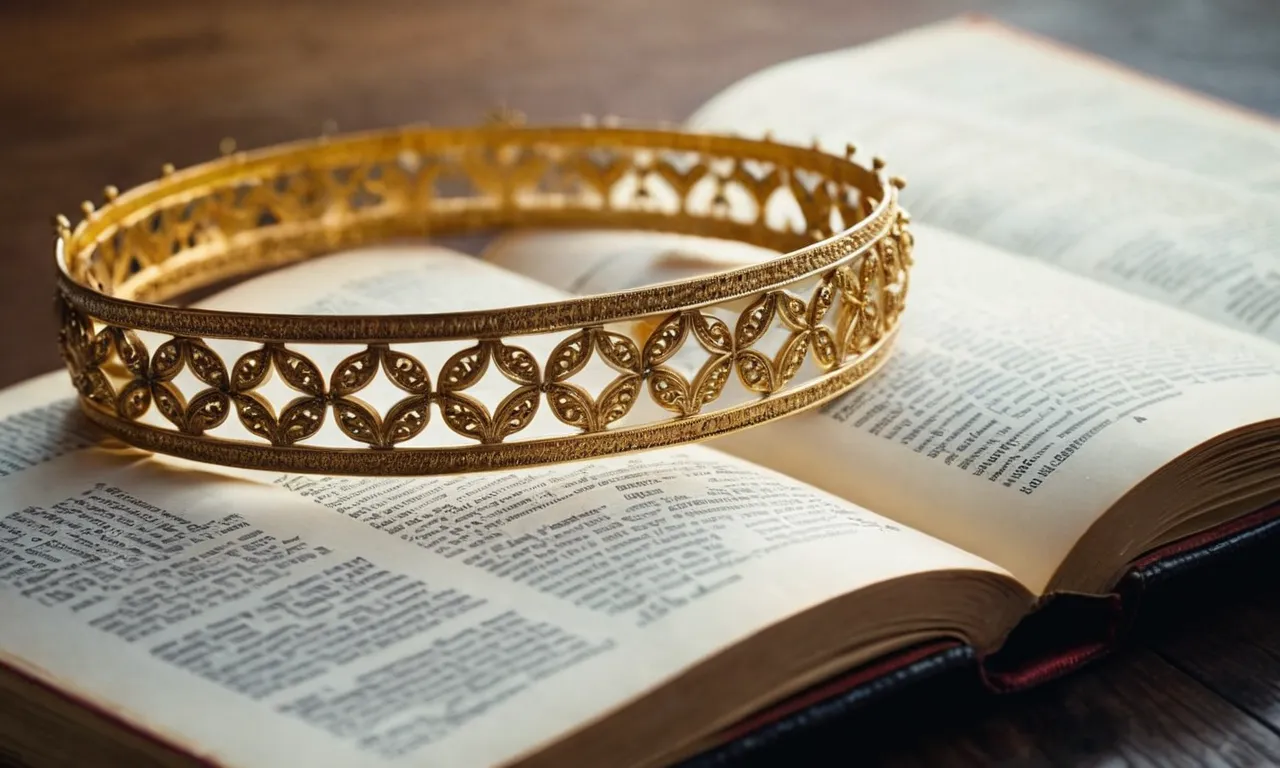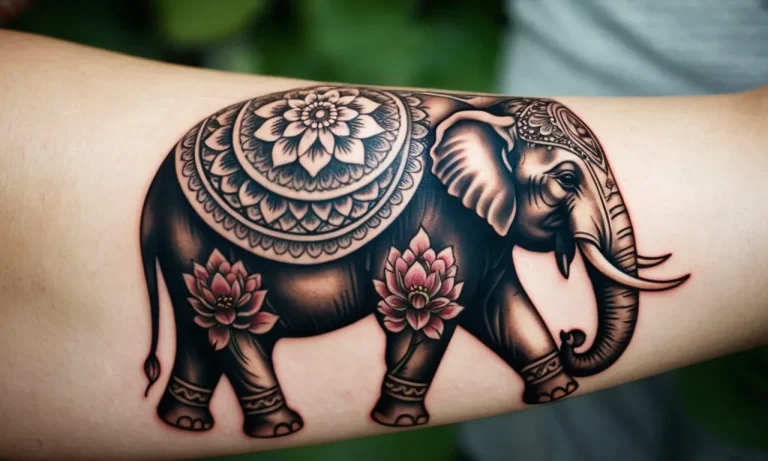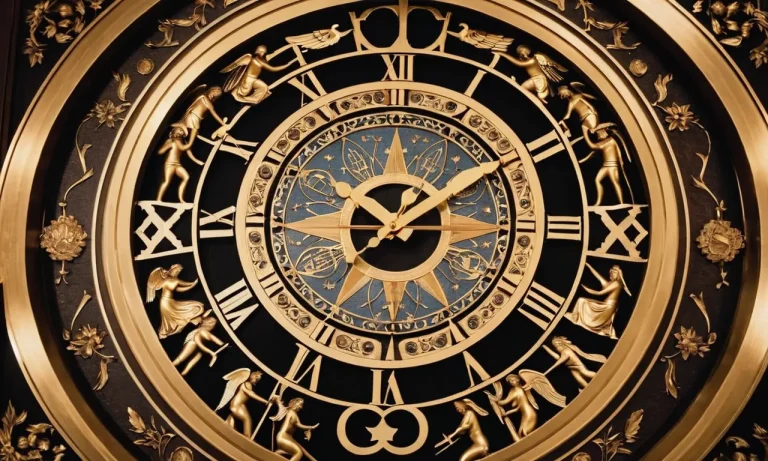What Is A Diadem In The Bible? A Comprehensive Guide
If you’re wondering what a diadem is in the bible, you’ve come to the right place. In short, a diadem is a decorative headband or crown worn by royalty in biblical times. But there’s much more to uncover about the diadem and its significance in scripture.
This roughly 3000 word guide will provide a comprehensive look at the diadem in the bible. We’ll explore what a diadem is, its origins and meaning, who wore diadems in the bible, why they wore them, examples of diadems, their symbolism and significance, and related biblical passages.
What is a Diadem?
A diadem is a type of crown or headpiece that was worn as a symbol of royalty and authority in biblical times. The word “diadem” comes from the Greek word diadema, which means “band” or “fillet.” It refers to the cloth or metal band worn around the forehead or head that often contained decorative elements.
Literal Definition of a Diadem
The literal definition of a diadem is a band, fillet, or headband worn as a symbol of royalty. In the ancient world, diadems were worn by kings, queens, and rulers as a sign of their sovereignty and right to rule.
They were often made of expensive materials like gold or silver and were embellished with precious stones, intricate metalwork, and other ornate designs.
Some key features of the literal meaning of diadem include:
- A band or fillet worn around the head
- Made of costly materials like gold or gems
- Ornately designed and decorated
- Worn as a symbol of regal authority and supremacy
- Distinguished the wearer as a person of royal or noble status
Distinguishing Features of a Diadem
There are several key features that distinguish a diadem from other types of crowns or headdresses:
- Position on the Head – Diadems sit lower on the head, like a circlet or headband, unlike taller crowns.
- Open Design – Most diadems are open-backed circlets rather than a complete crown enclosing the whole head.
- Simplicity – Diadems tend to be a simple decorative band, not overly elaborate like some crown designs.
- Lack of Arches – Arched crowns lift off the head while diadems generally have no arches and stay closer to the head.
- Materials – Diadems could be made of cloth, leather, or metal versus rigid materials used in crowns.
Additionally, diadems were sometimes treated as more feminine headdresses in contrast to more masculine crowns. They were also considered subordinate to larger, more imposing crowns designating the highest levels of authority.
Origins and Meaning of Diadem
Etymology of Diadem
The word “diadem” comes from the Greek word diádēma, which referred to a white headband worn by Persian kings as a sign of royalty. Later, the diadem evolved into a more ornate crown or tiara encrusted with jewels and precious metals.
In the ancient world, diadems signified the supreme power and authority of kings and queens.
The first references to diadems in the Bible come from the Old Testament books written during the Persian empire, when local rulers served under the Persian monarch. These vassal kings were allowed to wear diadems as a marker of their semi-autonomous power under the Persian king of kings (Isaiah 62:3).
Symbolic Meaning and Significance
In the Bible, diadems symbolize majesty, honor, royalty and virtuous dignity. By extension, the word took on connotations of fame, splendor, and celebration of worthiness. New Testament passages use the diadem as a metaphor for the victory, glory and festal joy awaiting those deemed righteous in the next life (Revelation 2:10, 3:11).
Careful biblical readers will notice that Satan wears seven diadems as the “prince of this world” while Christ wears many diadems as “Lord of lords and King of kings” at his triumphant return (Revelation 12:3, 19:12).
This contrast reveals how temporary evil powers are no match for the supreme, everlasting dominion of the Messiah. Through this imagery, the diadem’s original association with regal authority takes on profound spiritual dimensions in the Bible.
Who Wore Diadems in the Bible?
Kings
Kings in biblical times were known to wear diadems as a symbol of royalty and authority. For example, King David and King Solomon both wore splendid golden diadems during their reigns (2 Samuel 12:30, 1 Chronicles 20:2). These crowns signified their power and status as rulers appointed by God.
Diadems were often passed down from one king to the next as a right of succession. Some kings even had multiple crowns for different ceremonial events. King Jehoash, for instance, had both a coronation crown and one he wore on special holy days (2 Kings 11:12).
Queens
Not only kings wore crowns in the Bible. Some influential queens also donned diadems as badges of honor. Queen Esther famously wore a royal crown when she approached King Ahasuerus unsummoned to plead for her people (Esther 5:1). Her courageous act saved the Jews from destruction.
Another Judean queen, Athaliah, seized the throne by force after her son King Ahaziah died. She is said to have worn a crown during her 6-year reign over Judah (2 Kings 11:3). So while most queens in the Bible went without diadems, exceptional women did wear them to assert legitimacy or power.
Priests
Priests in the Bible at times wore special head coverings akin to crowns. These likely differed from royal diadems in opulence and meaning, but they carried religious significance. God commanded Moses to have “holy crowns” made for Aaron the high priest (Exodus 39:30).
These were to contain the engraving “Holy to the Lord.” When officiating important services, the high priest would wear this crown to represent holiness and honor. Later priests like Johanan were also described as wearing “crown” turbans when performing priestly duties (Zechariah 6:11).
So priests’ headwear conveyed their special status as religious officiants.
While diadems typically embodied political authority,
select religious leaders and female royals also wore crown-like coverings in special cases.
But the vast majority of crowns in the Bible appeared on the heads of powerful male rulers. These gleaming symbols proclaimed to all their exalted position as kings ordained to lead.
Why Did Biblical Figures Wear Diadems?
Symbol of Royalty and Honor
In biblical times, diadems were often worn by kings, queens, and other members of royal families. They symbolized royal authority, honor, and prestige. For instance, when King David led the procession of the Ark of the Covenant into Jerusalem, he wore a linen ephod and a diadem (2 Samuel 6:14).
The diadem visibly set David apart as the rightful king chosen by God. Similarly, when Queen Esther prepared to approach King Xerxes uninvited, she put on her royal robes and diadem, demonstrating her position as queen (Esther 5:1). The diadem was an irrefutable mark of royal status.
Diadems also signified honor for those crowned as victors or rulers. When King Joash of Judah was presented to the people after the death of the wicked Queen Athaliah, he wore a diadem to represent his new position as the rightful king (2 Kings 11:12).
The high priest Zadok performed a coronation ceremony and placed the diadem on Joash’s head, publicly declaring him the honorable new king. Thus, diadems were a meaningful symbol of royal privilege.
Sign of Beauty and Adornment
In addition to denoting royalty, diadems were prized as beautiful ornaments and crowns. The elegance of a diadem amplified the splendor of the wearer’s appearance. For instance, the prophet Ezekiel described the impressive attire of the King of Tyre, stating that he had “the seal of perfection, full of wisdom and perfect in beauty” with “ornaments” including a grand diadem (Ezekiel 28:12-13).
The diadem added striking beauty and grandeur to his regal visage.
Likewise, when the prophet Isaiah depicts the Lord clothing Jerusalem in splendor after a time of mourning, he says “a diadem of beauty will be the crown of the remnant of his people” (Isaiah 28:5). Here, the diadem represents the beautiful adornment of God’s people, emphasizing their new state of joy after sorrow.
The radiance of a diadem was a mark of aesthetic glory and festive decoration.
Representation of Power and Authority
In the Bible, diadems often symbolized the power and authority of rulers and even spiritual beings. For example, the seven heads of the beast in Revelation 13:1 are described as having diadems, representing this entity’s far-reaching worldly authority.
It also depicts Christ returning with “many diadems” (Revelation 19:12), alluding to his supreme, divine power as King of kings and Lord of lords.
Similarly, when King Darius honored Daniel for his excellent spirit and fidelity, he commanded all his officials to “tremble and fear” before Daniel’s God (Daniel 6:26). Darius declared that Daniel’s God was “the living God enduring forever; His kingdom shall never be destroyed, and His dominion shall be to the end.”
Here, Darius uses diadems to represent the mighty and everlasting dominion of the Almighty God.
Thus, diadems were a bold emblem of the considerable power and control exerted by mighty kings and the one true God over all other earthly authorities. The image of diadems conjured up awe for the formidable supremacy they represented.
Examples of Diadems in the Bible
The Diadem of the King of Tyre
The book of Ezekiel mentions the impressive diadem worn by the king of the ancient city of Tyre. Ezekiel 28:12 describes this king as having “the seal of perfection, full of wisdom and perfect in beauty.”
His crown is later referred to as a “diadem” (Ezekiel 28:12), indicating it was a fancy golden headband that represented his royal authority.
However, this passage also warns that despite the king’s wisdom and riches, his pride would lead to his downfall. Ezekiel 28:17 says the king’s “heart was proud because of his beauty; he corrupted his wisdom for the sake of his splendor.”
This diadem ultimately could not protect him from God’s judgment.
The High Priest’s Diadem
The high priest of Israel also wore an ornate diadem or headplate as part of his sacred vestments. Exodus 28:36-38 describes this headplate of pure gold, engraved with the inscription “Holy to the Lord.”
The high priest was instructed to wear this diadem on his forehead whenever he entered the Holy Place, so that he could bear the iniquities of the holy offerings of the Israelites.
This diadem marked the high priest as sanctified and set apart for service to God. It was tied to his mitre or turban, forming part of his sacred vestments. The diadem served as a reminder of the holiness required of the high priest as he carried out his duties and responsibilities in the tabernacle.
The Diadem of the Daughter of Zion
The prophet Isaiah uses the metaphor of a diadem to describe the city of Jerusalem. In Isaiah 62:3, the prophet says, “You shall be a crown of beauty in the hand of the Lord, and a royal diadem in the hand of your God.” Here, the Daughter of Zion refers poetically to Jerusalem.
Though once desolate and forsaken, Isaiah prophesies that Jerusalem will again be seen as beautiful, majestic, and honored. Like a radiant diadem adorning a noblewoman, the city will be a stunning crown of glory in God’s hand. Isaiah encourages the people that God has not forgotten or abandoned them.
Interestingly, the Hebrew word for diadem used in this verse is the same one used for the high priest’s headplate. Like the high priest, Jerusalem is described as being sanctified and set apart for God’s purposes.
The diadem represents the city’s royal dignity and honored status as God’s chosen location for his temple.
Symbolism of the Diadem in Scripture
Glory of God
In the Bible, the diadem often symbolizes the glory, authority and sovereignty of God. Isaiah 62:3 refers to God’s people as “a crown of splendor in the Lord’s hand, a royal diadem”. This conveys that those who follow God will share in His magnificent radiance.
Similarly, the 24 elders in Revelation 4:10 are said to cast their crowns before God’s throne, denoting that all glory belongs to the Almighty. The splendorous crown points to the supremacy of the Lord.
Righteousness and Purity
The diadem also represents righteousness, holiness and purity. In Revelation 19:12, Christ wears “many crowns” upon His head, signaling His perfect sinlessness. As Hebrews 1:9 states, He has been anointed with “the oil of gladness beyond His companions”.
The oil likely refers to olive oil used for consecration. Thus, Christ’s crown indicates His complete sanctification. For believers, the crown is a promised reward for righteous living (2 Timothy 4:8). Much like gold, the lustrous diadem symbolizes moral and spiritual purity.
Majesty and Splendor
As an ornamental headdress, the diadem radiates majesty and splendor. Passages like Ezekiel 21:26 and Isaiah 28:5 use crowns to represent the dignity of a monarch. The Cambridge Bible for Schools and Colleges notes that the dazzling tiara denoted “the authority and might of the royal wearer.”
For instance, King Belshazzar flaunted his power by using confiscated temple vessels at his banquet (Daniel 5:2). The stolen cups and goblets were likely adorned with glittering diadems. Thus, the resplendent headpiece points to the pomp and eminence of earthly rulers.
The diadem is indeed a multifaceted biblical symbol. The illustrious crown epitomizes God’s glory, believers’ righteousness, and rulers’ magnificence. As Bible Study Tools sums up, “It was the symbol of royal majesty, power, and glory.”
The gleaming headdress permeates Scripture with rich imagery of sovereignty, virtue and eminence.
Related Biblical Passages About Diadems
Isaiah 62:3
In Isaiah 62:3, the prophet Isaiah speaks of Zion being “a crown of splendor in the Lord’s hand, a royal diadem in the hand of your God.” This passage uses the imagery of a diadem to represent the glory, honor, and splendor that God will bestow on Zion.
As a royal diadem adorns the head of a monarch, Isaiah prophesies that Zion will be like a beautiful crown adorning the Lord. Just as a diadem often features precious jewels, Zion will sparkle and shine with God’s rich blessings.
Ezekiel 21:26
The prophet Ezekiel uses the diadem in a prophecy about the destruction of Judah in Ezekiel 21:26, stating that the diadem will be removed until the one comes to whom it rightfully belongs. The diadem here likely represents the throne and kingdom of Judah.
By removing the diadem, God is allowing Judah’s kingdom to be overturned and asserting his sovereign right over who rules on the throne. Yet God promises that one day the diadem will return – a future messianic king who will rule justly.
Revelation 12:1
The apostle John sees a vision of a woman “clothed with the sun, with the moon under her feet and a crown of twelve stars on her head” in Revelation 12:1. The crown here is implied to be a diadem, with the twelve stars representing the twelve tribes of Israel.
This woman is symbolic of God’s faithful people. The diadem shows that God’s people are royalty, crowned with the glory and honor of being his treasured possession. Yet the diadem may also represent the suffering experienced by God’s people, as they share in Christ’s sufferings.
While diadems in the Bible can represent earthly ideas of power, status, and wealth, more importantly they symbolize God bestowing glory, honor, and authority on his people or Christ. Diadems ultimately point to the sovereignty of God and his messianic reign.
Conclusion
In summary, the diadem in the bible was an ornate headpiece worn by royalty and priests. It represented honor, authority, and righteousness. Different diadems symbolized the glory, purity, and splendor of God.
While diadems are no longer commonly worn today, their rich meaning in scripture gives us insight into God’s majesty and the high position of those set apart for His purposes.








